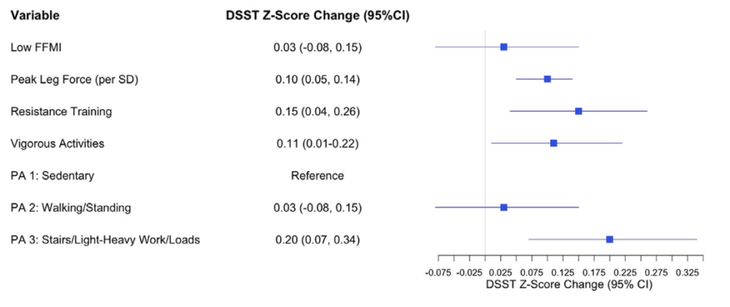Resistance training has two jobs: to make you stronger, and to make your muscles bigger. These two jobs are connected, since bigger muscles are usually stronger. But they’re not identical. You can get stronger without adding muscle, for example by improving how well signals are carried from your brain to your muscles, or how effectively your existing muscle fibers are recruited. And you can add muscle without necessarily getting functionally stronger, which typically happens when you gain weight.
This distinction between strength and muscle is at the heart of , which explores how each of these parameters influences the rate of cognitive decline in older adults. As a skinny endurance athlete who dutifully hits the gym, I’ve long wondered whether my pull-ups and squats are pointless, since I never seem to put on any muscle. But the new results, from a team led by Kristi Storoschuk of Queen’s University in Canada and Thomas Wood of the University of Washington, are reassuring.
Storoschuk and her colleagues pulled data from 1,424 adults over the age of 60 enrolled in the National Health and Nutrition Examination Study (NHANES) between 1999 and 2002. The subjects underwent DEXA scans to assess body composition, leg strength tests, a cognitive test called the , and various questionnaires that assessed things like physical activity habits. The DEXA scan was used to compute an “appendicular lean mass index” (ALMI), which approximates how much muscle you have in your arms and legs, and a “fat-free mass index” (FFMI), which reflects total muscle relative to height.
The key result was that strength was a much better predictor of cognitive performance than muscle mass. Strength explained about 5 percent of the variance in cognitive scores, while muscle mass explained only 0.5 percent. Moreover, whatever cognitive benefits muscle itself had seemed to be mediated by added strength. This isn’t as obvious as it sounds. One theory is that muscle tissue should also be considered an “,” sucking up glucose from the bloodstream and secreting molecules called myokines that are thought to benefit health and brain function. In this view, simply having lots of muscle should protect against cognitive decline, regardless of how you use it. But the NHANES data didn’t support this view: muscle only mattered insofar as it made you stronger.
These findings agree with an earlier analysis of NHANES data (which I wrote about here) that explored the links between strength, muscle, and mortality. Like the current results, that study found that low strength raised the risk of premature death, but low muscle mass didn’t. In contrast, a big study from McGill University did find that low muscle mass predicted more rapid cognitive decline over the three-year follow-up period, even after accounting for differences in strength.
There are lots of possible explanations for the conflicting results, including different populations, different cognitive tests, and different sample sizes. As a result, it would be premature to conclude that muscle mass doesn’t matter at all. Storoschuk and her colleagues suggest that there’s a distinction between muscle that you acquire from physical activity and muscle that you acquire in the process of gaining weight. In large population studies like NHANES, greater muscle mass may be predominantly a signal of larger body size rather than greater strength, which doesn’t seem to translate into protection from cognitive decline and other health benefits.
In terms of practical takeaways, I found the following figure from Storochuk’s paper interesting. It presents the relative benefits of several different variables on cognitive performance. The farther to the right each square is, the greater the cognitive benefits it’s associated with.

Sure enough, having low FFMI (i.e. low muscle mass) has no significant effect on cognitive scores, while peak leg force, a measure of strength, does have a significant benefit. What’s interesting to me is that the effect is even stronger for the next category, which is those who reported doing resistance training at least once per week. (The other categories below, like Vigorous Activities, include a mix of resistance and aerobic activity, so it’s hard to draw any conclusions about strength or muscle from them. Suffice to say that aerobic exercise is also good for the brain.)
Here’s what I take from all this: Having more muscle is very likely a good thing, and I’ll keep trying to add some, or at least avoid losing what I’ve got. Getting stronger is even better, and I will draw motivation from the fact that, regardless of whether I’m adding muscle, I do see tangible gains over time in the weights I lift and the number of reps I can handle for a given exercise. But the most important and beneficial thing of all, judging from that graph above, is the simple fact that I’m doing resistance exercise in the first place.
For more Sweat Science, join me on and , sign up for the , and check out my book .


